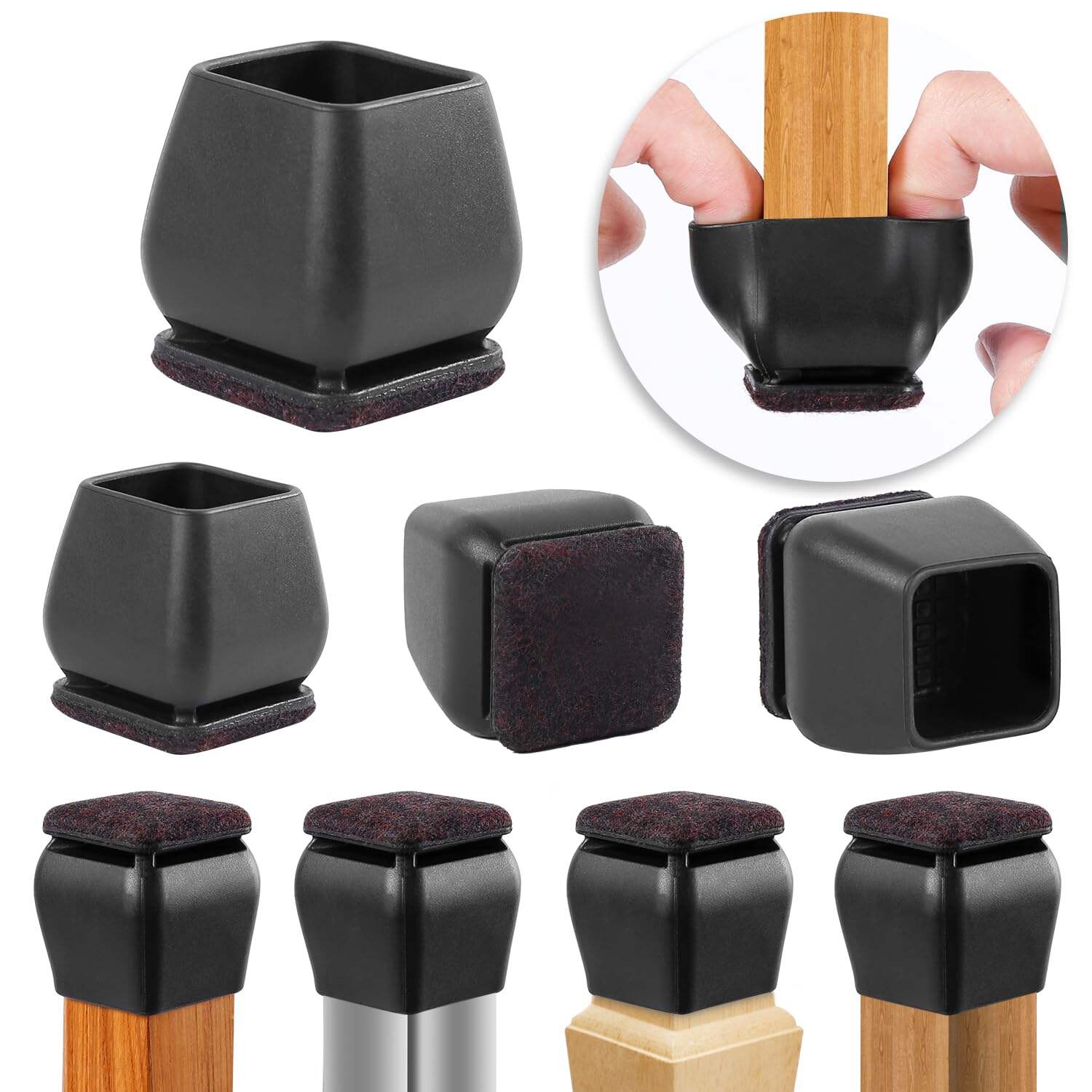How Can Chair Leg Caps Protect Floors from Scratches in Daily Use?
Protecting your floors from daily furniture damage is a constant concern for homeowners and business owners alike. Every time you move a chair, slide it across the floor, or simply sit down and shift your weight, the chair legs create friction that can lead to unsightly scratches, scuff marks, and permanent damage to your beautiful flooring. Chair leg caps offer an elegant and cost-effective solution to this persistent problem, providing a protective barrier between your furniture and floors while maintaining the aesthetic appeal of your space.
The versatility of modern floor protection solutions extends far beyond simple rubber caps, encompassing advanced materials like silicone, felt, and specialized polymer compositions. These innovative products are designed to address various flooring types, from delicate hardwood and luxury vinyl to polished concrete and tile surfaces. Understanding how these protective accessories work and selecting the right type for your specific needs can save you thousands of dollars in floor repairs and refinishing costs over time.
Understanding Floor Damage Mechanisms
Types of Scratches and Surface Damage
Floor scratches occur through multiple mechanisms, each requiring different protective approaches. Surface scratches affect only the top finish layer and appear as light marks that catch light differently than the surrounding area. These typically result from lightweight furniture movement and can often be polished out with proper refinishing techniques. Deep scratches penetrate through the finish into the actual flooring material, creating permanent grooves that require professional repair or board replacement in severe cases.
Scuff marks represent another category of floor damage, appearing as dark streaks or rubber deposits left behind by chair legs. Unlike scratches, scuffs primarily involve material transfer rather than physical gouging. However, repeated scuffing can lead to surface abrasion and eventual wear-through of protective coatings. Understanding these different damage types helps in selecting appropriate protective measures and maintenance schedules for your specific flooring investment.
Impact Forces and Pressure Distribution
The physics of floor damage involves concentrated pressure points where chair legs meet the surface. A typical dining chair can exert hundreds of pounds of pressure per square inch at these contact points, especially when someone sits down forcefully or rocks in the chair. This concentrated force exceeds the damage threshold of most flooring materials, creating indentations, scratches, and surface compression that accumulates over time.
Proper chair leg caps work by distributing this concentrated force over a larger surface area, reducing the pressure per square inch below the damage threshold. The best protective caps also introduce a cushioning element that absorbs impact energy, further reducing the potential for floor damage. This principle explains why larger cap surfaces generally provide better protection than smaller ones, assuming proper material selection and installation.

Material Science Behind Protective Caps
Silicone Technology and Benefits
Silicone chair leg caps represent the cutting edge of floor protection technology, offering superior durability and performance characteristics compared to traditional rubber alternatives. The molecular structure of silicone provides excellent flexibility while maintaining shape memory, allowing these caps to conform to minor floor irregularities while returning to their original form. This adaptability ensures consistent contact and protection across various surface textures and conditions.
The non-marking properties of high-quality silicone make it particularly suitable for light-colored floors where dark rubber caps might leave stains or marks. Silicone also resists temperature extremes, maintaining its protective properties in environments with significant heating or cooling fluctuations. The material's inherent chemical resistance prevents degradation from cleaning products, floor waxes, and other common household chemicals that might compromise inferior materials over time.
Felt Integration and Composite Designs
Modern chair leg caps often incorporate felt components to enhance their protective capabilities. Felt provides an additional layer of cushioning while creating a smooth gliding surface that reduces friction during chair movement. This dual-layer approach combines the structural integrity of silicone or polymer bases with the gentle contact characteristics of natural or synthetic felt materials.
The integration of felt into cap designs requires careful consideration of adhesive systems and replacement schedules. High-quality felt maintains its loft and protective properties for extended periods, but eventually requires replacement as fibers compress and wear away. Some advanced designs feature replaceable felt inserts, allowing users to maintain optimal protection without replacing the entire cap system.
Installation Techniques and Best Practices
Sizing and Fit Considerations
Proper sizing represents the most critical factor in chair leg cap effectiveness. Caps that are too loose will shift during use, potentially causing more damage than they prevent, while overly tight caps can split or deform, compromising their protective function. Measuring chair leg dimensions accurately requires attention to both outer diameter and any tapering or decorative elements that might affect cap placement.
Square and rectangular chair legs present unique fitting challenges compared to round alternatives. The cap must accommodate corner radiuses and potential size variations between different legs on the same chair. Quality manufacturers provide detailed sizing charts and sometimes offer sample packs to ensure proper fit before committing to full sets. Taking time to verify fit eliminates the frustration of returns and ensures optimal floor protection from day one.
Adhesive and Mechanical Attachment Methods
Some chair leg caps rely purely on friction fit, while others incorporate adhesive elements or mechanical fastening systems. Friction-fit caps work well for stable furniture that moves infrequently, but may require periodic readjustment as materials relax over time. Adhesive-backed caps provide more secure attachment but can be challenging to remove and may leave residue on chair legs when replacement becomes necessary.
Mechanical attachment methods, such as screw-on caps or clip systems, offer the most secure connection but require modification of the chair legs. This approach works well for valuable furniture where permanent protection justifies minor alterations. The choice between attachment methods depends on furniture value, usage patterns, and personal preferences regarding permanent versus removable modifications.
Performance Analysis Across Flooring Types
Hardwood Floor Protection Strategies
Hardwood floors require particularly careful protection due to their susceptibility to both impact damage and moisture-related issues. Chair leg caps for hardwood applications must balance protective effectiveness with breathability to prevent moisture trapping that could lead to wood warping or finish clouding. The cap material should also complement the natural expansion and contraction cycles of wood flooring systems.
Different hardwood species exhibit varying scratch resistance levels, with harder woods like oak and maple showing better resistance than softer species like pine or fir. However, even the hardest woods benefit significantly from quality chair leg caps, as the protective investment pays dividends in reduced refinishing frequency and maintained appearance over decades of use. Professional floor installers often recommend cap installation as part of new hardwood floor maintenance programs.
Tile and Stone Surface Considerations
Ceramic, porcelain, and natural stone floors present different protection challenges compared to wood surfaces. While these materials resist scratching better than wood, they are more susceptible to chipping and cracking from impact forces. Chair leg caps for tile applications must focus on impact absorption rather than just scratch prevention, requiring materials with superior cushioning properties.
Grout lines create additional complexity in tile floor protection, as chair legs can catch on raised grout joints and create concentrated stress points. Caps with larger contact patches help bridge grout lines and distribute forces across multiple tiles simultaneously. The caps must also resist degradation from tile cleaning chemicals, which tend to be more aggressive than wood floor maintenance products.
Long-term Maintenance and Replacement
Monitoring Cap Condition and Performance
Regular inspection of chair leg caps ensures continued floor protection and identifies potential issues before they cause damage. Visual inspection should focus on wear patterns, material degradation, and secure attachment to chair legs. Caps showing uneven wear may indicate chair stability issues or floor irregularities that require attention beyond simple cap replacement.
Performance monitoring involves checking for any new floor marks or scratches that might indicate cap failure or displacement. A systematic approach to inspection, perhaps monthly for high-use chairs and quarterly for occasional-use furniture, helps maintain consistent protection levels. Documenting cap installation dates and replacement schedules helps predict maintenance needs and budget for ongoing protection costs.
Replacement Schedules and Upgrade Opportunities
Chair leg cap lifespan varies significantly based on usage patterns, flooring type, and material quality. High-traffic commercial applications might require replacement every six months, while residential settings could see caps lasting several years. Establishing replacement schedules based on actual wear patterns rather than arbitrary timeframes optimizes both protection and cost-effectiveness.
Technology improvements in cap materials and designs create opportunities for upgrades during replacement cycles. Newer materials might offer superior protection, easier installation, or better aesthetic integration with your furniture and flooring. Staying informed about product developments ensures you benefit from the latest protective technologies as they become available in the marketplace.
FAQ
How do I determine the correct size chair leg caps for my furniture
Measure the outside dimensions of your chair legs at the point where the caps will sit, typically at the bottom. For round legs, measure the diameter, and for square or rectangular legs, measure both width and depth. Most manufacturers provide sizing guides, and when in doubt, it's better to choose slightly larger caps that can accommodate minor variations rather than caps that might be too tight and difficult to install.
Can chair leg caps damage certain types of flooring
Quality chair leg caps are designed to protect rather than damage flooring, but improper selection or installation can cause issues. Avoid caps with hard plastics or rough surfaces that might scratch delicate floors. Always choose caps specifically rated for your flooring type, and ensure they remain clean and free of debris that could cause abrasion during chair movement.
How often should chair leg caps be cleaned or maintained
Clean chair leg caps monthly or whenever you notice debris accumulation. Remove the caps if possible and wash with mild soap and water, ensuring they're completely dry before reinstallation. Inspect for wear, cracks, or material degradation during cleaning sessions. Replace any caps showing significant wear or damage to maintain optimal floor protection.
Are expensive chair leg caps worth the additional cost compared to basic options
Higher-quality chair leg caps typically offer better materials, more precise sizing, longer lifespan, and superior floor protection. When protecting expensive flooring, the cost difference between basic and premium caps is minimal compared to potential floor repair expenses. However, for temporary applications or lower-value flooring, basic caps may provide adequate protection at a reasonable cost.

 EN
EN
 AR
AR
 BG
BG
 HR
HR
 CS
CS
 DA
DA
 NL
NL
 FI
FI
 FR
FR
 DE
DE
 EL
EL
 HI
HI
 IT
IT
 JA
JA
 KO
KO
 NO
NO
 PL
PL
 PT
PT
 RO
RO
 RU
RU
 ES
ES
 SV
SV
 CA
CA
 TL
TL
 IW
IW
 ID
ID
 LT
LT
 SR
SR
 SK
SK
 SL
SL
 UK
UK
 VI
VI
 HU
HU
 TR
TR
 AF
AF
 MS
MS
 GA
GA
 LA
LA
 MN
MN



